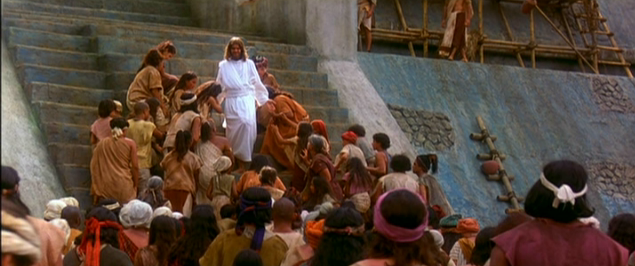To accompany your Come Follow Me study for September 23-29
You will enjoy watching the following dramatizations of Christ’s visit to the Americas:
If you didn’t watch The Testaments of One Fold and One Shepherd recently, you may enjoy watching it this week at:
Here is another 12 minute video, which includes some footage from the preceding one:
You may also enjoy watching the following related videos:
You will also want to consult the following related commentary from the Institute of Religion Book of Mormon Student Manual:
If you would like a Kahoot game related to this material which you could use for personal study or use with your family or your class, click here: https://create.kahoot.it/share/3-nephi-8-11/78127379-4aaa-4f3b-b9c4-694a74632092 . To use it with a group, after clicking on this link, you will need to log into Kahoot, creating a free account if you have not done so previously, then click on the blue “Host Live” button or the gray “Assign” button, depending on how you wish to use the Kahoot. Some of the Kahoot questions may presuppose that the player has read through the suggested answers to the following Points to Ponder and at least has browsed the Institute student manual as well.
Points to Ponder in 3 Nephi 8-11
1. Why did the Savior have to kill so many thousands of Nephites? If people don’t want to accept His way of life, why doesn’t He let them “do their own thing” without getting so angry about it?
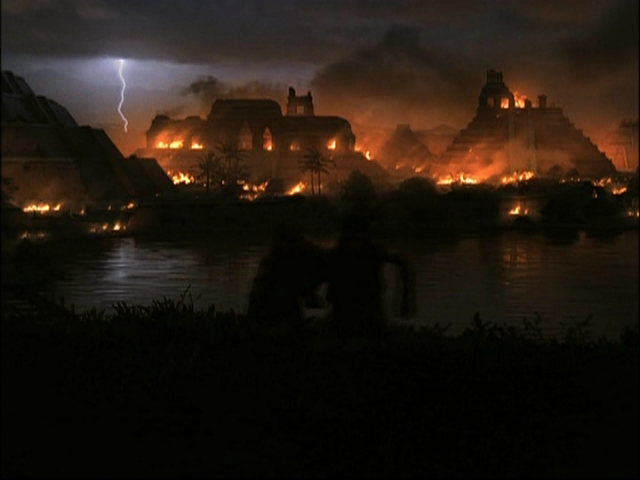
2. How can it be called a sacrifice to be broken hearted and contrite? (9:20) How does this passage relate to D&C 59:9, which says we should “offer up” our sacraments? How does offering up our sacraments differ from partaking of the bread and water?

3. Joseph Smith said, “No man can receive the Holy Ghost without receiving revelation,” but 3 Ne. 9:20 Indicates that the Holy Ghost fell on the Lamanites at the time of their conversion and “they knew it not.” Is it possible that an entire group received revelations without knowing it? Explain.
4. Did Jesus’ appearance to the Nephites occur “soon after” His ascension or “in the ending of the thirty and fourth year,” which would be nearly a year later? How are we to understand 10:18, which if read carelessly could seem to contradict itself?
5. What do you find most impressive about the 3 Nephi account of Jesus’ coming to the Nephites? Is this how you picture the Second Coming? Why or why not?
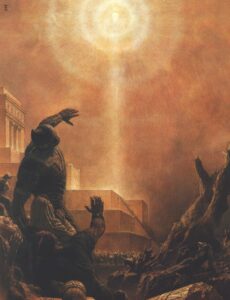
6. 11:3-7. Why would the Nephites have had to hear the divine voice three times before understanding it? What other scriptural story does this remind you of?

7. 11:14. Why doesn’t Jesus say that he is the “Son of the God of the whole earth” rather than “the God of the whole earth”?

8. What was the first recorded thing Jesus did after his appearance to the Nephites, after a few introductory words?
a. Conferred upon Nephi the power to baptize
b. Introduced the sacrament to the Nephites
c. Called twelve Nephite disciples to head his church
d. Invited the multitude to feel the marks in his hands, feet, and side
e. Called for their statistical reports
9. About how long would you estimate the above would have taken, given the information in 17:25?
10. 11:21. Didn’t Nephi already have the priesthood? What is going on in verse 21?
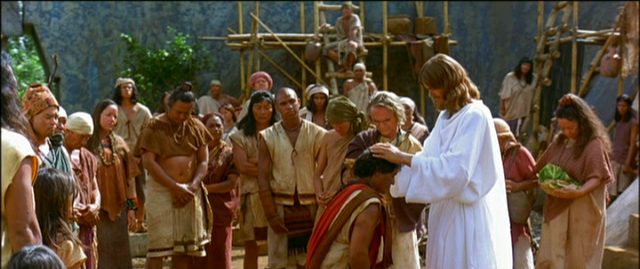
11. 11:25. Why is this baptismal prayer different from the one in D&C 20:73? Could you use either one?
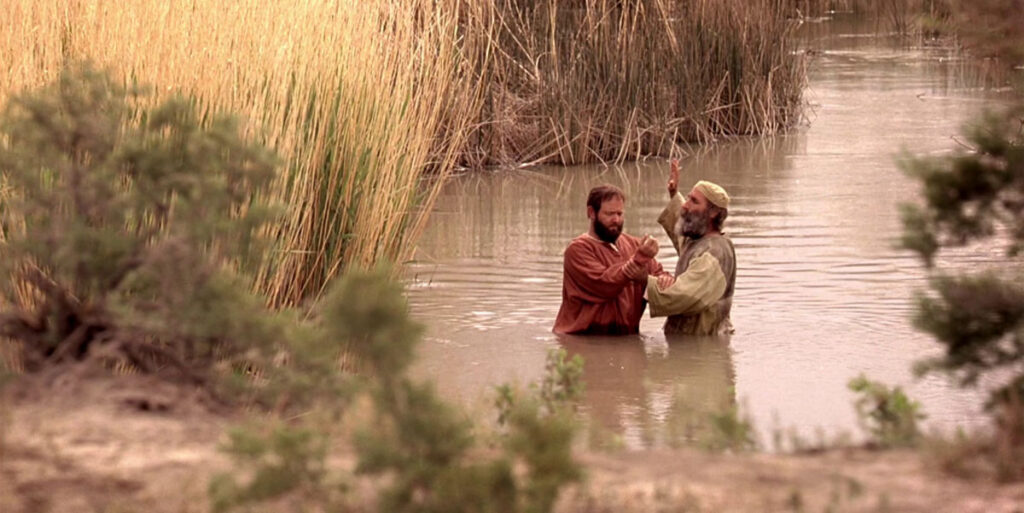
12. 11:27. Wouldn’t it be clearer that the Father, Son, and Holy Ghost were separate beings if the scriptures didn’t so often say they were one? What does Jesus mean when he says, “I am in the Father, and the Father is in me”?

13. 11:28-30. Where is this counsel most often violated? What should you do if someone in your gospel doctrine class makes a false statement concerning a doctrinal matter?

14. 11:31-40. Can you condense the Savior’s definition of His “doctrine” down to ten words or less?
15. 9:22; 11:37-38. In what respects are we to resemble little children? Aren’t they most often immature, incompetent, forgetful, ignorant, unruly, dirty-faced, and fussy?

16. What other points in 3 Nephi 8-11 are worth emphasizing?
Possible Answers to Points to Ponder in 3 Nephi 8-11
1. Why did the Savior have to kill so many thousands of Nephites? If people don’t want to accept his way of life, why doesn’t He let them “do their own thing” without getting so angry about it?
The Lord warns His people of potential destruction in an attempt to get them to change and thus avoid the unhappiness which always accompanies sin. He sometimes must carry out His threats and destroy the wicked both for their sake and for the sake of their prospective victims. By forcibly preventing them from sinning any more than they have, He keeps them from having even more to answer for in eternity, and at the same time He fulfills His promises to the righteous that they can eventually live in peace without harassment from their enemies.
2. How can it be called a sacrifice to be broken hearted and contrite? (9:20) How does this passage relate to D&C 59:9, which says we should “offer up” our sacraments? How does offering up our sacraments differ from partaking of the bread and water?
Our pride may be the toughest thing to give up. Certainly, it qualifies as a “sacrifice,” as David taught in Psalms 51:17. In the sacrament, when we covenant to subordinate our will to Christ’s, we are making just this sacrifice, provided we really mean what the covenant implies and are not simply “partaking of the bread and water.” You may also enjoy watching the following short video on the subject:
3. Joseph Smith said, “No man can receive the Holy Ghost without receiving revelation,” but 3 Ne. 9:20 Indicates that the Holy Ghost fell on the Lamanites at the time of their conversion and “they knew it not.” Is it possible that an entire group received revelations without knowing it? Explain.
Certainly, it is possible. Revelation must not only be received, it must be recognized and interpreted. No doubt these Lamanites felt warm, wonderful feelings of peace, love, and hope, though only later would they learn the source.
4. Did Jesus’ appearance to the Nephites occur “soon after” His ascension or “in the ending of the thirty and fourth year,” which would be nearly a year later? How are we to understand 10:18, which if read carelessly could seem to contradict itself?
It is probably not so important to know exactly when Jesus came as to know that He did come. But it may be important to know that the Book of Mormon does not contradict itself. It seems clear that Jesus really did come “soon after” His ascension into heaven. Nearly a year later the multitude would not likely still be marveling and pointing out to each other “the great and marvelous change which had taken place” (11:1). Nor would there have been any point in waiting so long after so dramatically getting everyone’s attention by the three days of darkness and after speaking to them from heaven in chapter 10. It appears that Mormon’s reference to the “ending of the thirty and fourth year” was simply to say that the year could be summed up, in retrospect, as one in which both the surviving Nephites and Lamanites “did have great favors shown unto them, and great blessings poured out upon their heads,” beginning with the Savior’s personal appearance to them.
5. What do you find most impressive about the 3 Nephi account of Jesus’ coming to the Nephites? Is this how you picture the Second Coming? Why or why not?
I find it impressive that after centuries of prophecies, faithful anticipation by some, and doubtful skepticism by others, Christ did actually come! I picture His descent similar in some ways to that of his Second Coming, but His Second Coming will be accompanied by great heat and light, with the righteous being caught up to meet Him and the earth being made new. Christ’s coming to the Nephites was comparatively small scale.
6. 11:3-7. Why would the Nephites have had to hear the divine voice three times before understanding it? What other scriptural story does this remind you of?
Maybe it was necessary for them to hear a garbled voice a couple of times before they would listen carefully enough to understand the third time. The record says that the third time they “did open their ears to hear it.” Maybe they at first were not sufficiently spiritually sensitive to understand the message. This reminds us of Samuel, who thought Eli was speaking to him until Eli told him to answer the Lord the next time He spoke.
7. 11:14. Why doesn’t Jesus say that he is the “Son of the God of the whole earth” rather than “the God of the whole earth”?
This is the God who spoke to Abraham, Isaac, and Jacob, who created the earth, etc. The fact that He is the Son of God the Father doesn’t lessen His own godly status.
8. What was the first recorded thing Jesus did after his appearance to the Nephites, after a few introductory words?
a. Conferred upon Nephi the power to baptize
b. Introduced the sacrament to the Nephites
c. Called twelve Nephite disciples to head his church
d. Invited the multitude to feel the marks in His hands, feet, and side
e. Called for their statistical reports

9. About how long would you estimate the above would have taken, given the information in 17:25?
If they each took only 10 seconds, this would have taken nearly seven hours for 2500 people to have the experience. This may dramatize how the Lord feels about individuals and the importance of individual attention as we minister to others.
10. 11:21. Didn’t Nephi already have the priesthood? What is going on in verse 21?
Perhaps this parallels the rebaptism of early Latter-Day Saints after the Church was organized. Certainly, Nephi had had the priesthood, but this may have been a ratification of that priesthood now that a new dispensation has dawned. Or maybe the Lord just wanted to make sure everyone knew who His appointed mortal leader was.
11. 11:25. Why is this baptismal prayer different from the one in D&C 20:73? Could you use either one?
They really mean the same thing. I suspect that if you used the Book of Mormon version, the baptism would still count. At least, I heard of one BYU religion professor who did use the Book of Mormon wording at least once when performing a baptism. But since D&C 20:73 is the latest word on the subject, and since we’d raise lots of eyebrows if we used the Book of Mormon wording, we may not want to mark ourselves as mavericks by trying it.
12. 11:27. Wouldn’t it be clearer that the Father, Son, and Holy Ghost were separate beings if the scriptures didn’t so often say they were one? What does Jesus mean when he says, “I am in the Father, and the Father is in me”?
Perhaps it would be clearer that they are separate beings, but I suspect that the Lord here is more concerned with establishing their oneness than their separateness–especially to people who were always being tempted to follow the multiple and conflicting gods of the pagan world. When he says “I am in the Father,” etc., I presume He is simply saying that He and the Father know each other so well and understand and support each other so perfectly that it is as though they were the same person.
13. 11:28-30. Where is this counsel most often violated? What should you do if someone in your gospel doctrine class makes a false statement concerning a factual or doctrinal matter?
We probably see the highest level of contention when we’re talking about political subjects, where we may mistakenly assume it is justified in order to oppose “evil,” as we see it. Unfortunately, we sometimes see violations of Jesus’ counsel even in our gospel doctrine classes, priesthood classes, and homes. Most erroneous factual or even doctrinal statements aren’t serious enough to warrant correcting. If and when someone really is seriously off base, and others could be irretrievably misled, we might tactfully suggest another way of looking at the subject, or inquire how the speaker’s position relates to a certain scriptural passage, rather than stridently contradict the other person.
14. 11:31-40. Can you condense the Savior’s definition of His “doctrine” down to ten words or less?
Faith, repentance, baptism, and the Holy Ghost.
15. 9:22; 11:37-38. In what respects are we to resemble little children? Aren’t they most often immature, incompetent, forgetful, ignorant, unruly, dirty-faced, and fussy?
Perhaps. But they are also usually humble, teachable, forgiving, and without guile, which is much more important.
16. What other points in 3 Nephi 8-11 are worth emphasizing?
Your choice. Possibilities could include:
- 8:1: Miracles can be done only by those cleansed every whit from iniquity.
- 8:19-22: The thick “mists of darkness” described here, in which no fire could be lit, sound like the probable result of a volcanic explosion. My great-grandfather, James Alma Slater, experienced such an eruption in 1886, during his mission in New Zealand. He and his companion took refuge in a barn some miles from the volcano but reported “although it was mid-day, it was darker than any night they had ever seen.”

- 9:7: Click below for an interesting short video about a sunken city in Lake Atitlán in Guatemala, possibly corresponding to the description given of sunken cities in the Book of Mormon at the time of Christ’s coming.
- 9:9-10: Click below for a short video concerning evidence for a major volcanic eruption corresponding to the destruction which burned several Nephite cities as described in 3 Nephi 9.
- 10:4-6: Imagery of a hen gathering her chickens

- 10:10: Present mourning can turn to joy.
- 10:12: It was the more righteous part of the people who were saved.
- 11:3: The voice of the Spirit is small but piercing, causing the heart to “burn.”
- 11:7: One of the few recorded times in which the voice of the Father is heard, introducing the Son and expressing His love for Him.
- 11:41: The Savior’s instructions not simply to believe, repent, be baptized, and receive the Holy Ghost, but to “declare the words which I have spoken, unto the ends of the earth.”

